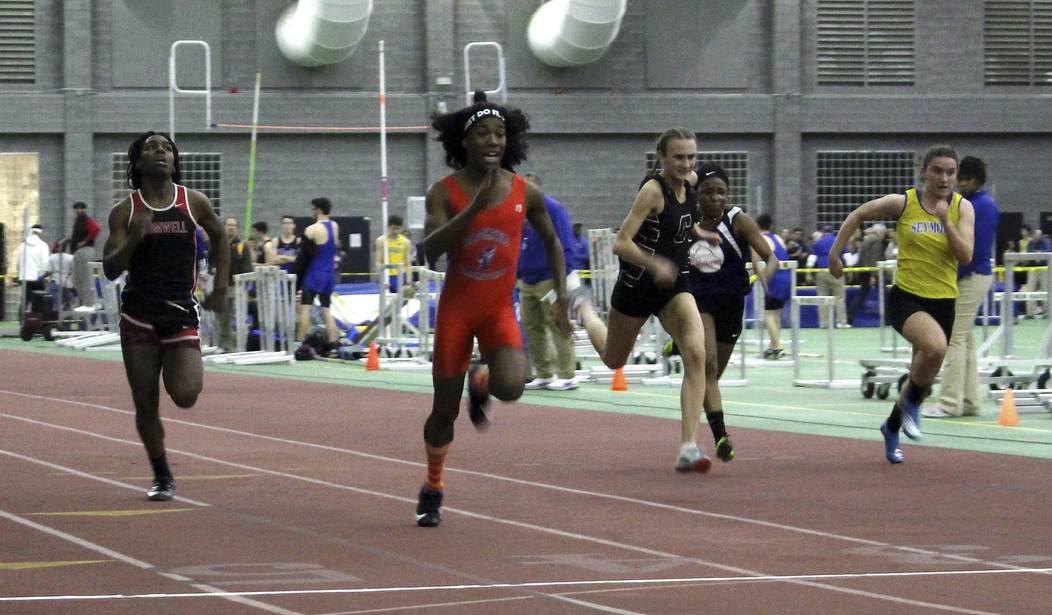Last year I wrote about the problems caused by allowing male student-athletes who “identify” as females to compete on the girls’ team in Connecticut. Well, the problems haven’t gone away. The same students causing controversy last year — Andraya Yearwood, a boy from Cromwell High School, and Terry Miller, a boy from Bloomfield High School — are still very much controversial this year.
Last year, Miller and Yearwood finished in the top two spots for the state’s 100-meter state outdoor championships. Miller also won the 300-meter state indoor championship this season. The event at issue now is the 55-meter dash at the state open indoor track championships. Miller and Yearwood once again took the top two spots, with Miller setting a record of 6.95 seconds, and Yearwood finishing in 6.95 seconds. The third place winner, a biological female, finished in 7.23 seconds.
Critics say their gender identity amounts to an unfair advantage, expressing a familiar argument in a complex debate for transgender athletes as they break barriers across sports around the world from high school to the pros.
“I have learned a lot about myself and about other people through this transition. I always try to focus most on all of the positive encouragement that I have received from family, friends and supporters,” Yearwood said. “I use the negativity to fuel myself to run faster.”
Connecticut is one of 17 states that allow transgender high school athletes to compete without restrictions, according to Transathlete.com, which tracks state policies in high school sports across the country. Seven states have restrictions that make it difficult for transgender athletes to compete while in school, like requiring athletes to compete under the gender on their birth certificate, or allowing them to participate only after going through sex-reassignment procedures or hormone therapies.
The other states either have no policy or handle the issue on a case-by-case basis.
Yearwood acknowledges she is stronger than many of her cisgender competitors, but says girls who are not transgender may have other advantages.
According to FairPlayForWomen.com, a nonpartisan grassroots campaign based in the UK dedicated to fighting for the sex-base rights of women and girls, there are a number of skeletal and muscular differences between men and women. Women are, on average, 9 percent shorter than men, and have shorter and weaker bones. Women also have shorter arms and legs relative to body size—one can easily see where longer legs might benefit males in track sports. As for muscles, women “are around 30-35% muscle by weight, while men are 40-50% muscle.” Women’s ligaments are also thinner and softer than men’s.
The impact these biological differences have when it comes to competitive sports is undeniable — and there are victims whose concerns are not being heard.
One of [Miller’s and Yearwood’s] competitors, Selina Soule, says the issue is about fairness on the track and has wider implications. The Glastonbury High School junior finished eighth in the 55-meter race, missing out on qualifying for the New England regionals by two spots.
Soule believes that had Miller and Yearwood not run, she would be on her way to race in Boston in front of more college coaches.
“We all know the outcome of the race before it even starts; it’s demoralizing,” she said. “I fully support and am happy for these athletes for being true to themselves. They should have the right to express themselves in school, but athletics have always had extra rules to keep the competition fair.”
But, the Connecticut Interscholastic Athletic Conference (CIAC) is bound by Connecticut’s anti-discrimination policies that dictate students’ gender identity trumps biological sex. Glenn Lungarini, CIAC’s executive director, tried to equate the issue with segregation. “This is about someone’s right to compete. I don’t think this is that different from other classes of people, who, in the not too distant past, were not allowed to compete.” The problem with Lungarini’s statement is that no one is saying Miller and Yearwood can’t compete. They have every right to compete… on the boys‘ team with other boys.
Denying biological differences between boys and girls is harming more people than it is helping. When boys are allowed to compete on girls’ teams it takes away opportunities from actual girls. I said last year that coaches, students, and parents need to take a strong stand against these unfair “anti-discrimination” policies that are pandering to social justice warriors at the expense of girls who just want to compete on a level playing field. Girls who have been competing in sports for years, hoping their hard work will give them opportunities down the road, are finding themselves derailed by students who only recently decided to call themselves girls.
_____
Matt Margolis is the author of The Scandalous Presidency of Barack Obama and the bestselling The Worst President in History: The Legacy of Barack Obama. His new book, Trumping Obama: How President Trump Saved Us From Barack Obama’s Legacy, will be published in 2019. You can follow Matt on Twitter @MattMargolis










Join the conversation as a VIP Member